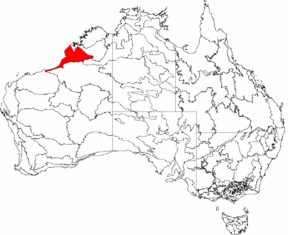Pindan facts for kids
Pindan is a special name for an area in the south-western Kimberley region of Western Australia. It's known for its unique red soil. The word "pindan" comes from a local language and describes both the soil and the types of plants that grow there.
Contents
Discovering Pindan: A Look at Its History
The word "pindan" first appeared in writing in 1883. It was mentioned by Mr. Edward Townley Hardman, a geologist. He wrote about "pindan ironstone" in a report about the Kimberley region.
Later, in 1891, Government Geologist Harry Page Woodward also described "pindan sands and gravel." He noted that these sandy soils were common near the Fitzroy River. He also said that even though they were often dry, they had a lot of plants because of the heavy rainfall.
Where is Pindan Country?
Pindan country is mainly found in a place called Dampierland. This includes the Dampier Peninsula and the area around Broome and Roebuck Bay. It also stretches along the coast south-west from Roebuck Bay, next to Eighty Mile Beach.
The climate in Pindan is semi-arid, which means it's quite dry. It has a tropical monsoonal climate. This means hot, wet summers and mild, dry winters. The land is mostly flat or gently rolling, with no big landmarks. This can make it easy to get lost!
Pindan Soil Characteristics
The soils in Pindan are usually red and sandy. They have a lot of clay and not many nutrients. These soils can get very dry during droughts. But they can also become waterlogged (too wet) when it rains a lot.
Plants and Animals of Pindan
The plants in Pindan country are a mix of different types. It's a meeting point between the wetter monsoon forests in the northern Kimberley and the dry Great Sandy Desert to the south-east.
Pindan Plant Life
Pindan is an open woodland with scattered trees. It's mostly filled with wattle trees, but you'll also find eucalypts and tall shrubs. Underneath these trees, there are grasses and smaller herbs.
During the long dry season, from April to November, many plants and grasses die off. The land looks very dry, and wildfires are common. These fires leave behind bare, blackened soil with dead shrubs.
However, during the short wet season, from December to March, the Pindan comes alive! Many different kinds of plants flower. This brings a wide variety of insects and other animals that enjoy the sudden abundance of food and water.
On higher ground, Pindan looks more like a savanna, with more open spaces. In low-lying areas that get very wet during the wet season, paperbark trees start to grow instead of other trees. The trees in Pindan are usually short, between 3 to 8 meters tall. They have deep roots and often have bent or twisted trunks.
In 1926, an explorer named Knut Dahl called the Pindan a "crippled forest." He said this because the trees looked very similar and seemed stunted.
Common Pindan Plants
Some typical trees and tall shrubs you might see in Pindan include:
- Wattles like Acacia eriopoda, A. tumida, A. monticola, A. platycarpa, A. colei, and A. adoxa.
- Eucalypts such as Corymbia greeniana, C. flavescens and C. zygophylla.
- Other plants like Grevillea wickhamii, G. refracta, Gyrocarpus americanus, Terminalia petiolaris, Lysiphyllum cunninghamii, Ventilago viminalis, Premna acuminata, Hakea microcarpa, Persoonia falcata, Atalaya hemiglauca, Gardenia pyriformis, Pavetta kimberleyana, Carissa lanceolata, Dodonaea hispidula, Ehretia saligna and Santalum lanceolatum.
Pindan Animal Life
Many animals that live in savannas are found in Pindan. For example, agile wallabies and red-winged parrots reach the southernmost part of their range in Western Australia in the Pindan area along Eighty Mile Beach.
See also
 In Spanish: Pindan para niños
In Spanish: Pindan para niños



